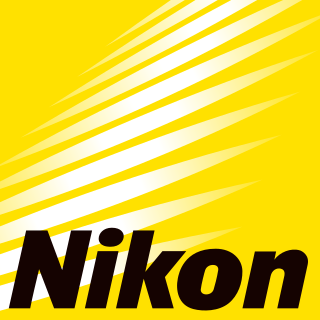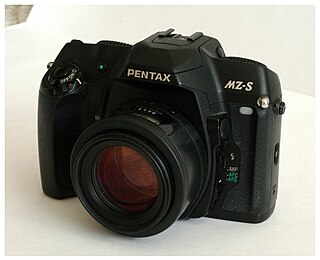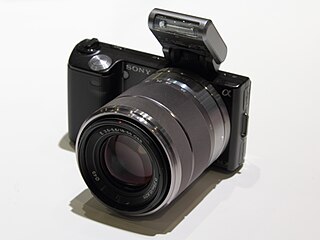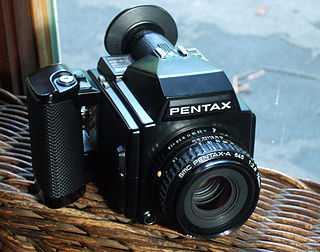
Pentax Corporation is a Japanese camera and optical equipment manufacturer, and currently, it exists as the Pentax Life Care Business Division of Hoya's medical endoscope business, as well as the digital camera brand of Ricoh Imaging, a subsidiary of Ricoh.

Nikon Corporation is a Japanese optics and photographic equipment manufacturer. Nikon's products include cameras, camera lenses, binoculars, microscopes, ophthalmic lenses, measurement instruments, rifle scopes, spotting scopes, and equipment related to semiconductor fabrication, such as steppers used in the photolithography steps of such manufacturing. Nikon is the world's second largest manufacturer of such equipment.

The Pentax K1000 is an interchangeable lens, 35 mm film, single-lens reflex (SLR) camera, manufactured by Asahi Optical Co., Ltd. from 1976 to 1997, originally in Japan. The K1000's extraordinary longevity makes it a historically significant camera. The K1000's inexpensive simplicity was a great virtue and earned it an unrivalled popularity as a basic but sturdy workhorse. The Pentax K1000 eventually sold over three million units.

Advanced Photo System type-C (APS-C) is an image sensor format approximately equivalent in size to the Advanced Photo System film negative in its C ("Classic") format, of 25.1×16.7 mm, an aspect ratio of 3:2 and Ø 30.15 mm field diameter. It is therefore also equivalent in size to the Super 35 motion picture film format, which has the dimensions of 24.89 mm × 18.66 mm and Ø 31.11 mm field diameter.
BorgWarner Inc. is an American automotive and e-mobility supplier headquartered in Auburn Hills, Michigan. As of 2022, the company maintains production facilities and sites at 92 locations in 24 countries, and generates revenues of US$15.8 billion, while employing around 52,000 people. The company is one of the 25 largest automotive suppliers in the world.

Chinon Industries Inc. was a Japanese camera manufacturer. Kodak took a majority stake in the company in 1997, and made it a fully owned subsidiary of Kodak Japan, Kodak Digital Product Center, Japan Ltd., in 2004. As a subsidiary, it continues to develop digital camera models.

The Pentax K10D and similar Samsung GX-10 are 10.2-megapixel digital single-lens reflex cameras launched in late 2006. They were developed in a collaboration between Pentax of Japan and Samsung of South Korea.

The Pentax MZ-S is a 35mm single-lens reflex camera from Pentax of Japan. It was introduced in 2001 and discontinued in February 2006. It is closely related to the prototype MZ-D Full-frame digital SLR, which never entered production. It was the top-of-the-line model of Pentax's MZ/ZX series and replaced the PZ-1p as the high-end Pentax camera. No camera was produced to replace the MZ-S, making it Pentax's last high-end 35 mm camera. The MZ-S is the last film camera from Pentax that was manufactured in Japan.
This article discusses the cameras – mainly 35 mm SLRs – manufactured by Pentax Ricoh Imaging Corp. and its predecessors, Pentax Corporation and Asahi Optical Co., Ltd.. Pentax must not be confused with Pentax 6x7 or Pentax 67 which are 120 medium format 6x7cm film cameras.

Pentax lenses were first badged as Takumar. The Takumar branded lenses were well respected for their line of Super Takumar, which designated the high performance coating applied to the lens as well as the optical formulas used to make them. The majority of the industry at the time was still satisfied with the variations of the "plumb" coating process and later some of the two and three layer processes as well. Asahi Pentax soon introduced the Takumar Super-Multi-Coated line of lenses which was a 7 layer process as the industry had just caught up with similar forms of 5 layer multi-coated optics. Eventually Asahi Optical and Pentax slowly shifted much of their lens production under the Pentax name and transitioned some of the successful designs that were first introduced under the Takumar name to use Asahi/Pentax badging as well as beginning to use the "smc" abbreviation. Eventually the Asahi partnership disappeared and the Pentax name became solely used. Pentax lenses saw many feature changes to answer the market, such as: incorporating "Auto-Aperture" with the M42, the light weight and compactness with the 'M' series, Aperture Priority overrides with the 'A' series, and Auto-Focus with the 'F' series. Modern Pentax lenses for digital SLR cameras have seen the elimination of the aperture ring completely as found on Pentax DA and D-FA series lenses. They use the Pentax KAF mount. All of these lenses have an autofocus feature, either operated from the camera body or from an internal SDM motor. Pentax compatible lenses are also made by third-party companies.

The Pentax Optio S50 is a digital compact camera announced by Pentax on August 16, 2004. It contains an early example of a selective colour filter.

The Sony α NEX-5 is a digital camera launched on 11 May 2010. It is a mirrorless interchangeable lens camera with the body size of a larger model fairly compact point-and-shoot camera with a larger sensor size (APS-C) comparable to that of some digital single-lens reflex cameras. Its major competitors in the market are the cameras based on the micro 4/3 standard created by Panasonic and Olympus, and a few low end Canon, Nikon, and even Sony α DSLRs. The NEX-5 shoots 14.2 megapixel stills and has a 7 frame/s continuous shotmode. It has the capability to shoot 1920×1080i at 60 frame/s in AVCHD or 1440×1080p at 30 frame/s in MPEG4. The NEX-5 was replaced by the 16 megapixel NEX-5N in August 2011.

Pentax K-01 is a mirrorless interchangeable-lens camera announced in February 2012. It uses the Pentax K mount.

The Pentax 645 is a medium format single-lens reflex system camera manufactured by Pentax. It was introduced in 1984, along with a complementary line of lenses. It captures images nominally 6 cm × 4.5 cm on 120, 220, and 70 mm film, though the actual size of the images is 56 mm × 41.5 mm.

The Pentax Q is a mirrorless interchangeable-lens camera introduced by Pentax on June 23, 2011.

The Pentax Optio E60 is a digital compact camera announced by Pentax on July 31, 2008. It uses AA batteries and therefore does not depend on a proprietary charger.

The Pentax Optio H90 is a digital compact camera announced by Pentax on January 25, 2010. It was launched under a new "functional beauty" design paradigm and was described as exhibiting "pleasant minimalism". It is compatible with Eye-Fi wireless SD cards and supports 720p video.

The Pentax K-1 is the first production Pentax full-frame digital SLR camera. As the flagship model of the Pentax K-mount system, it includes several new and improved features, including a five-axis SR II in-body image stabilization system, newly designed flexible tilt articulating screen mounted on four metal struts allowing for rotation about the optical axis in addition to upward and downward tilt, and improved autofocus and metering systems.



















